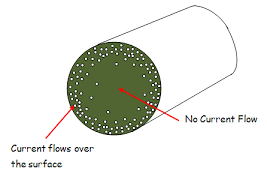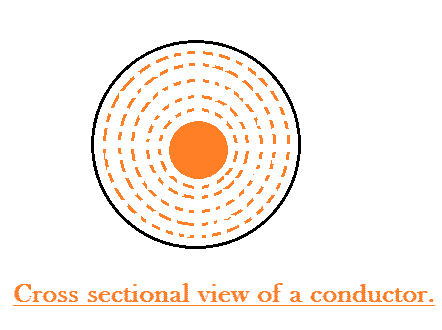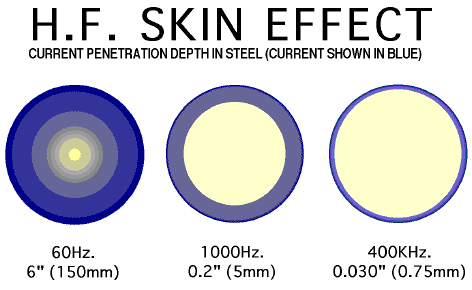Explanation-1
You know AC current has inductance effect. If you imagine a conductor from microscopic view, a conductor became millions of heirs like thin conductor (filaments). Each of heirs will carry current and create magnetic fields as well as electric fields.

But Electric field can flow only on surface and not inside a solid conductor. Current creates magnetic field and voltage creates electric field. Due to nature of AC (frequency), magnetic field changes inside the conductor and affects the thin filaments due to self and mutual inductance. Hence, an alternating current flowing through a conductor does not distribute uniformly but tends to concentrate near the surface of the conductor. In fact, in ac system no current flows through the core and the entire current is concentrated at the surface regions. The result is that the effective area of the conductor is reduced causing an increase in its ac resistance. The effective ac resistance is usually referred as the effective resistance of the conductor. The phenomenon is called the skin effect as it causes concentration of current at the skin of the conductor.
The distribution of current over the cross-section of the conductor is uniform for DC only.
Explanation-2
The skin effect can be easily explained by considering a solid conductor to be composed of a large number of annular filaments, each carrying a fraction of total current.

The flux linkages due to the filaments lying at the surface link the whole of the conductor while the flux set up due to the inner filaments does not link with the surface or outer filaments. Thus the filaments near the centre are of larger inductance than that near the outer surface. The high reactance of the inner filaments causes the current to distribute in such a way that the current density is less in the interior of the conductor than at the surface. The distribution of current over the section will, therefore, be non-uniform, as shown in fig.

Factors affect the skin effect
The skin effect depends upon (i) type of material (ii) frequency (iii) diameter of conductor, and (iv) shape of conductor.
At low frequencies the effect is very small; in fact it is only of importance with high frequencies or with solid conductors of larger cross-section.
Screen effect and effective resistance of solid copper conductors for frequency of 50 Hz or less:
- Upto 1 cm in diameter- negligible
- For 2 cm diameter- about 2.5 percent
- For 2.5 cm diameter- 8 percent
In an aluminium wire the effect is the same as in a copper wire of equal conductivity. Thus since the resistivity of copper is 0.6 times that of aluminium, the increased resistance due to skin effect on an aluminium wire of a square mm in cross-section will be of the same percentage as on a 0.6 a square mm in copper wire.
The skin effect is much smaller with stranded conductors than with solid conductors. It increases with the increase of cross-section, permeability and supply frequency.
In practice stranded conductors are invariably used for transmission and distribution lines and hollow conductors for solid bus-bar. This is done in order to overcome the adverse effects of skin effect.